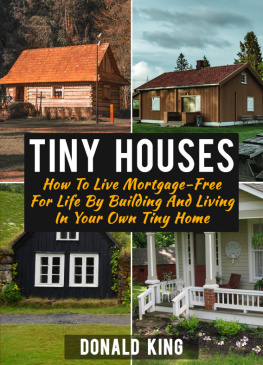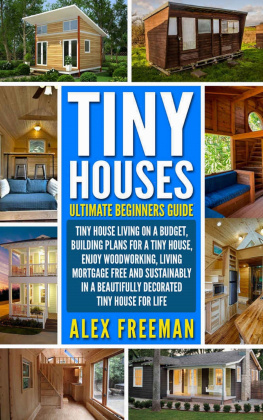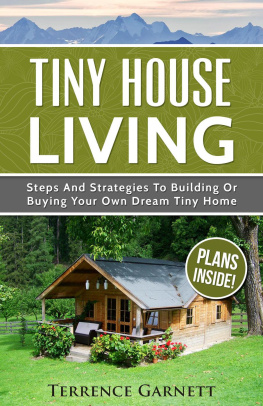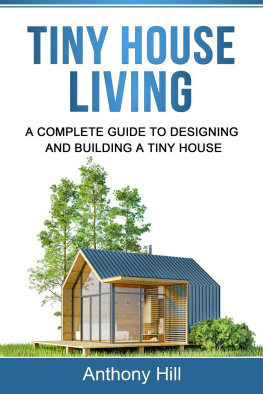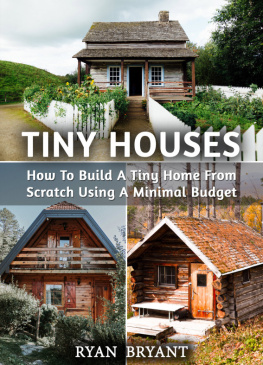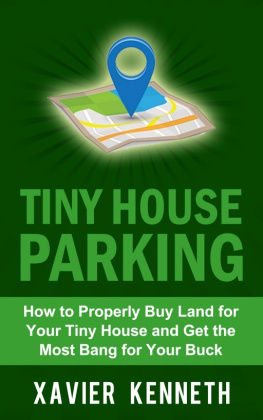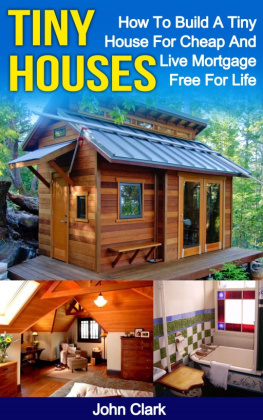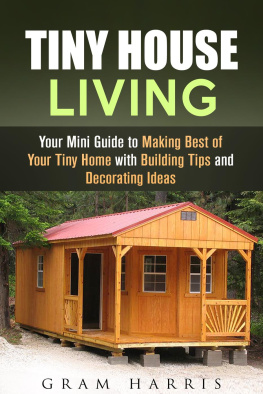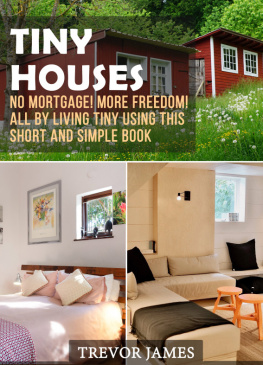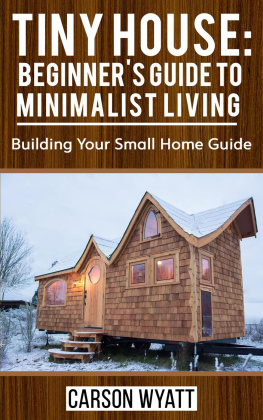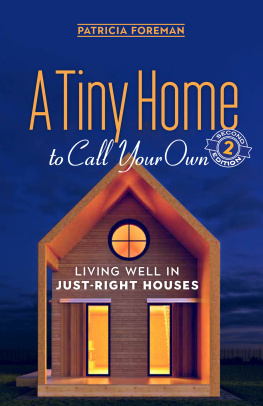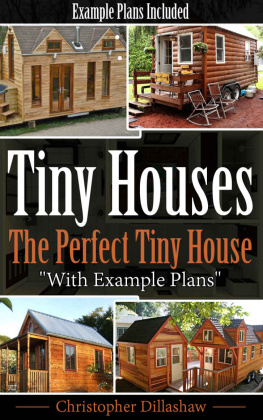Ti nyHouses
How ToLive Mortgage-Free For Life By Building And Living In Your Own TinyHome
Copyright 201 2 by Donald King - All rights reserved.
This document is geared towardsproviding exact and reliable information in regards to the topicand issue covered. The publication is sold with the idea that thepublisher is not required to render accounting, officiallypermitted, or otherwise, qualified services. If advice isnecessary, legal or professional, a practiced individual in theprofession should be ordered.
- From a Declaration ofPrinciples which was accepted and approved equally by a Committeeof the American Bar Association and a Committee of Publishers andAssociations.
In no way is it legal toreproduce, duplicate, or transmit any part of this document ineither electronic means or in printed format. Recording of thispublication is strictly prohibited and any storage of this documentis not allowed unless with written permission from the publisher.All rights reserved.
The information provided hereinis stated to be truthful and consistent, in that any liability, interms of inattention or otherwise, by any usage or abuse of anypolicies, processes, or directions contained within is the solitaryand utter responsibility of the recipient reader. Under nocircumstances will any legal responsibility or blame be heldagainst the publisher for any reparation, damages, or monetary lossdue to the information herein, either directly or indirectly.
Respective authors own allcopyrights not held by the publisher.
The information herein isoffered for informational purposes solely, and is universal as so.The presentation of the information is without contract or any typeof guarantee assurance.
The trademarks that are used arewithout any consent, and the publication of the trademark iswithout permission or backing by the trademark owner. Alltrademarks and brands within this book are for clarifying purposesonly and are the owned by the owners themselves, not affiliatedwith this document.
Chapter 1: The Tiny Home Building Plan
Before you bring out thebricks and mortar, it is important for you to develop a list ofneeds and expectations from your tiny house, and to develop a planof action through which you can meet them. Needs are defined asirreplaceable and essential components to your living space, whichcannot be replaced or omitted. An example of a universal need incontext with a tiny house would be the need to have waterproofroofing and a bathroom. What to Consider when Choosing a Site forBuilding Your Tiny House It seems that tiny homes are popping uparound the USA almost anywhere that people find suitable space.This movement is backed by peoples peoples keenness to savemoney, cut down on their carbon footprint, as well as to enjoy analternate experience of what it feels like to live in a tiny world.However, it is easier said than done to build a tiny house andsettle down in it as a number of things have to be taken intoconsideration. You may even be forced to change your ways and meansin life altogether such as your choice of lifestyle or how yousetup the house for residence. Plumbing and ElectricalConsiderations Probably the easiest thing to do with plumbing for atiny house is not to have any plumbing at all in the house. Whilethis does not mean that you will have to live in a dry, water-freeenvironment it goes a long way towards reducing the aspects ofautomation around the building. This way you are almost agreeing touse only the amount of water that is needed in your house andsaving any unnecessary wastage. By doing so, you get to carrydifferent amounts of water round to different parts of your home.You can have a small quantity stored near your dishes, some nearthe sink, and again a small amount in the bathroom where you canthen enjoy a gravity-fed shower. The water will likely be carriedaround in jugs, bottles, and buckets so finding a site that isclose to a constant fresh water supply will be a good choice tostart with. In case you are unable to do so then you need to buy alarge volume of water and have it stored somewhere in your home.With space being at a premium around the tiny space, this may notbe a suitable option for all. The main advantage of living in ahome that does not have any kind of plumbing is that you wont berequired to deal with the issues that normally come up with havingplumbing setups around the home. It will also make your tiny homecost a lot less than most other tiny homes around the area. Whetheryou are happy with making numerous trips to fetch water is entirelyat your discretion. When it comes to electrical considerations, a24V DC system is easily the most efficient option. You will be ableto avoid a great deal of complexity with this kind of a setup. Youshould consider having appliances that run directly on a 24V DC,especially the freezer since it will be one appliance that drawsmaximum electricity. The market available for such products is nota very big one so you may have to do some amount of searching toget hold of the right appliance but the many hours of toil willdefinitely be worth it. In case you are unable to find a DC model,you can still go ahead with a normal AC product and then have itpowered by a pure sine wave inverter. Adapters are also availablethat can convert the DC voltage to a suitable AC voltage for use incharging such appliances. Fixed telephone lines have become almosta thing of the past as mobile communications have taken over thesphere. Also, a steady decline in mobile broadband internet hasalso ensured that more individuals are shifting towards the use ofthese devices for their web usage. As a result, there is simply noneed to have thick unsavory cables moving in and out of your tinyhome. Honestly speaking, they can be a major eye sore so doing awaywith them is easily the smartest solution. Opting for an ACinverter to power everything in the tiny house is not a goodchoice. While such inverters have become more reliable than before,being completely reliant on them is not a good option. It is alwaysrecommended that you keep the electrical supply balanced between anAC supply and a DC input. Making a Plan of Action By a Plan ofAction or POA, we are referring to a two-pronged planning processwhich involves the following: Listing out your needs andexpectations clearly in terms of priority , Developing abuilding plan which incorporates the aforementioned needs It isimportant for tiny house builders and enthusiasts to take a momentto understand the difference between a need and a want whileorganizing their plans. Some tips which might come in handy whiledifferentiating between wants and needs are shared below: Most tinyhouses will need to incorporate the following areas or spaces:Sleeping area or bedroom, a kitchen with or without a dining space,one or multiple bathrooms, and a sitting or office area. For largerfamilies with pets or children, additional free space might berequired. For those who work from home it will be essential todedicate space for a comfortable and quiet working zone. A numberof tiny house builders want to cram a lot of elements into theirspaces, but must understand that the basics need to be coveredfirst. Once the aforementioned essential spaces are built, it willbe easier to build on the existing structure and incorporate otherelements such as entertainment centers, additional seating areas,or maybe even a sustainable indoor gardening patch. A considerabledegree of cost analysis will be done while listing out needs anddeveloping the plan of action; through this you will be betterinformed as to where you can cut costs and save money on buildingsupplies. As mentioned earlier, it is important to focus onbuilding the basics and then adding other elements from yourwants list. Making a list of wants and needs will thereforefacilitate the process of developing an actual building plan. Hereare a few sample building plans of tiny houses which incorporateessential elements as prioritized by their owners. The stepstowards developing clarity in context with your tiny house buildingplan and vision therefore, involve the following: Acquiring detailsin terms of the exact square foot area of your tiny house in orderto know how much room you have to divide or modify. Basic buildingmaterials, which will be required in order to complete the framingof your tiny house (and their cost). You might want to include thecost of hiring professional contractors or others whose servicesyou might wish to engage; however most tiny houses can be easilyconstructed using basic DIY guidelines and basic tools. You willneed to prioritize the essential components of your home; this isfor two reasons, firstly because you should invest in premiumquality electricity/water related wires, cables, and othernecessities which are best bought firsthand; secondly because yourhouse and its foundations must be solid, durable, and able towithstand constant use. Once you have these three steps taken careof, you will also develop a rough idea as to how much you canafford to invest in terms of rooms and spaces within your tinyhouse. Adhering to your budget is of primary importance. You willnow need to organize the following: Making a list and dividing itinto two sections; Needs and Wants Editing the list and omittingunnecessary elements, while keeping a section titled To Do Laterfor projects which are close to your heart, for example, awall-to-wall section for your book collection. Developing a basicidea as to how much each needs-based space will cost to construct;it is a good idea to come up with a ballpark figure in order to beable to cut costs later. Avoid writing the lowest possible cost ofconstruction as costs are more likely to increase rather thandecrease, and you do not in any way want to derail your budget. Itis best to be pragmatic and factor in some extra money in case ofan urgent construction based requirement. While an entire chapterhas been dedicated towards discussing building checklists,individual room planning, and ergonomics, there is no reason as towhy you cannot begin organizing your thoughts in context with themat the very onset of your planning process. It is highlyrecommended that you keep a whiteboard or journal handy in order torecord thoughts, ideas, names of websites and dealers from whom youcan purchase from or barter items with, and friends who may beinterested in helping you construct your tiny house.
Next page
